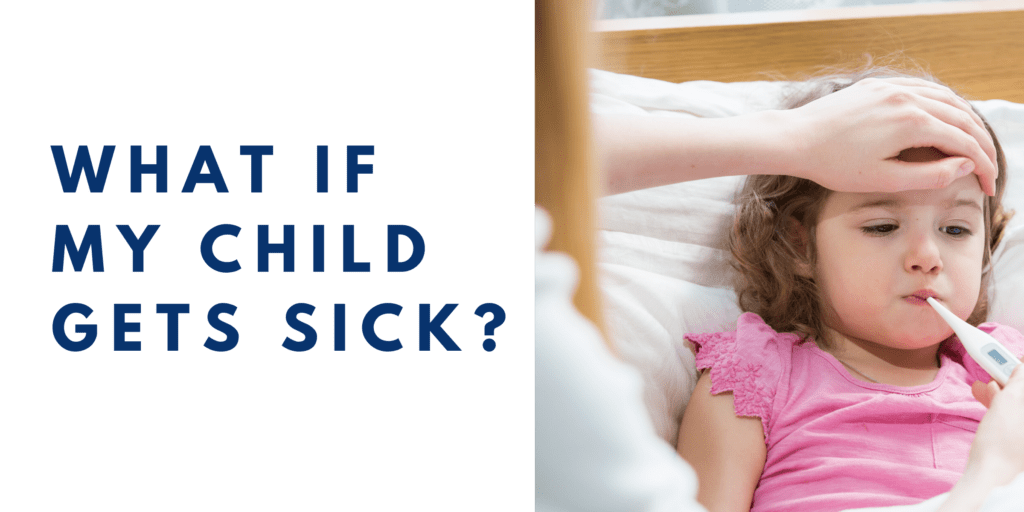
So you’re looking to raise a happy healthy child. Welcome to the club. All parents want this. This is our fundamental goal as parents. But isn’t it normal for children to be kind of germy and sick? To have allergies and to need antibiotics regularly? Afterall, their innate immune systems are just forming so it should be normal for a child to catch coughs, colds and flu. Right?
Not to set off any panic alarms but it isn’t actually natural for a child to be sick all the time. Sure. Kids get sick and sometimes kids get very sick. But ultimately what you want to see is a happy healthy child who fights off colds easily and for the most part is functioning at full speed. This is the sign of a healthy child.
If this is the goal how do you get there? If the goal is happy healthy children who are well most of the time, what can we do differently to ensure that this is the case? We’re going to go over some of the fundamentals for a healthy child. If you’d prefer fewer doctor’s visits and more time spent at the playground then stick around. We’ve got a lot to share.
Pop Quiz!
Maybe you didn’t think we would be starting with a pop quiz for you. We understand that you want the answers to healthier happier children. The fact is that no two children are alike. So, even though we are going to give some generalized recommendations for healthy children we still think it is important for you to answer the following questions for your own children. Grab a sheet of paper or open a word processing document and jot down some notes.
1. How good is your child’s nutrition?
- Great.
- Pretty good but we have some areas for improvement.
- Not great. We get some vegetables in but after a lot of coaxing
- Poor. My child is the pickiest eater on the planet
2. What is your child’s lifestyle and stress levels?
- Fine. S/he plays outside a lot and has a nice balance between school work and fun.
- Busy. I have noticed s/he comes home with a mountain of homework and I’m pretty sure they eliminated their second recess
- Not great. I suspect my child may be getting bullied at school or something else could be going on.
- Poor. We are considering therapy as there is clearly something bothering him/her.
3. Does your child have tummy troubles?
- Very rarely
- Occasionally
- Regularly
- We’re in chronic tummy trouble mode all the time.
4. How often does your child get exercise or outdoor play time?
- Every day for about three hours
- I think our child probably gets outside for 90 minutes or 2 hours a day
- We have to coax our kiddo out and then it’s for an hour or less
- Our child doesn’t get outside very much.
Take some time now to write down any other areas in your child’s life that you believe need some improvement.
Did this help? We think that focusing on areas that are most crucial first is a good strategy for raising happy healthy children. Trying to do it all at once and change it all at once can be overwhelming and often doesn’t encourage lasting change.
Most children need improvement to their nutrition. But how much improvement is optimal?
Next we are going to take a look at good nutrition for children. Good nutrition is the cornerstone for a happy healthy life for children, teens, and adults. The good news is that kids who eat well tend to eat well throughout their lives. So if you are looking to make changes in nutrition then great! Think of this as your opportunity to set your child up for good outcomes now and throughout their entire life.
Great Nutrition For Kids

It’s okay to have a picky eater. That’s normal. Remember many of the healthy foods that we now like to eat we acquired a taste for.
A general rule for great nutrition for children is to make sure that your children eat an entire rainbow of foods every single day.
Some of us acquired a taste for healthy foods later in life while other of us can’t remember a time when we didn’t eat fruits and vegetables.
One of the best ways to encourage children to eat healthy foods is to model it. So, the first thing to do is to include more vegetables and fruits in your own diet. Even if your child won’t eat every bite of their broccoli over time they will learn that this is how they eat (by example) and before long your child will be more willing to consume healthy fruits and vegetables.
Take a look at some of the healthiest whole foods for kids.
A Rainbow of Whole Delicious Foods
Red:
- Apples
- Apple Sauce
- Cherries
- Radishes
- Kidney Beans
- Pomegranate
- Strawberries
- Raspberries
- Sweet Red Bell Pepper
- Tomato
Orange:
- Apricots
- Cantaloupe
- Butternut Squash
- Carrots
- Grapefruit
- Mango
- Nectarine
- Sweet Potato
- Orange
- Winter Squash
Yellow:
- Corn
- Corn on the Cob
- Yellow Bell Pepper
- Kale
- Spinach
- Succotash
Green:
- Asparagus
- Avocado
- Bean Sprouts
- Bell Pepper
- Broccoli
- Brussel Sprouts
- Cabbage
- Celery
- Chard
- Cucumbers
- Green Beans
- Green Peas
- Greens of all kinds (collard, mustard, dandelion, turnip, beet)
- Lettuce
- Olives
- Spinach
- Snow Peas
- Watercress
Blue/ Purple:
- Blackberries
- Blueberries
- Carrots
- Dates
- Eggplant
- Grapes
- Purple Kale
- Plums
- Potatoes Purple
- Raisins
- Purple or Black Rice
Tan:
- Bean Dips
- Garlic
- Hummus
- Legumes
- Nuts Onions
- Refried Beans
- Shallots
- Tahini
*Source Functional Medicine Tool Kit
As you can see there are lots of foods to choose from. So choose one from each color and build from there. If your child already eats celery, apples, and grapes then great. Add some new foods in and try pairing them with foods they already enjoy. Will they try a cherry tomato with their celery one day? Does a bit of hummus help to get the carrots down a bit easier? A little bit of peanut butter may help your child enjoy celery. Ants on a log is a classic recipe that incorporates three of the colors in just one snack. Introduce the same foods again and again until they reliably eat them then build from there. It’s a good approach to increasing food for children.
Foods to Avoid

Unfortunately food marketing targets children in a number of unhelpful ways. Of course the most unhealthy foods are the target for ads and placement like sugary cereals, candy, and
soda. If only healthy foods were widely promoted. Well if that were the case we would have far fewer kids with health problems in America. Still there are a few foods that sap your child’s immune system and should be completely avoided.
- Sugar
- Artificial Sugar
- Juice
- Soda
- Artificial Ingredients
- High Fructose Corn Syrup
High fructose corn syrup is not actually a food, it’s a substance that has been extracted from corn stalks and is not something that our bodies are designed to digest. The substance bypasses the GI tract and goes straight into our bloodstream and immediately creates a sugar rush. This triggers the production of fats in the liver. High fructose corn syrup compromises ATP and can contribute to leaky gut. Leaky gut can lead to a whole host of conditions including autoimmune conditions. Avoid High Fructose Corn Syrup (AKA HFCS, Corn Syrup)!
All of these energy dense foods cause weight gain and do not contribute to your child’s nutritional needs.
Sugary drinks are the largest source of added sugar. 80% of American kids drink about 20 or more ounces of sugar drinks each day. This is 17 teaspoons of sugar in just one drink!
Most fruit juices have just as much sugar as soda. Fruit juice actually deters children from eating their regular foods and as a result is associated with stunted growth.
About 4,000 kids are diagnosed with type 2 diabetes each year. It is essential to limit or eliminate sugar from a diet. There are always opportunities for children to eat sugar- birthday parties at school, birthday parties out of school, vending machines, snack time with a friend, and the list goes on and on. Cutting sugar may seem tricky but may be the single most impactful thing that you do to change your child’s well being for the better.
Sugar can cut immune function in half. If you want a healthy kid consider kicking the sugar.
Gut Wellness
A healthy gut is important for extracting the vitamins that we need from our food. There’s new evidence regularly linking the well being of our gut to our mental well being including developmental disorders like autism. As much as 90% of all serotonin is produced in the gut- a strong link between gut wellness and depression.
Our gut provides protection against harmful bacteria and a healthy gut is associated with lower instances of allergies, asthma, diabetes, autoimmune disease and obesity.
Tips for Healthy Gut Wellness
Learn to Chew. Chewing is the first act of digesting! Remember that our intestines don’t have teeth. Teaching children to chew foods slowly is an important habit that will likely stay with them for life. This is another behavior that is reinforced through modeling. Most of us need to learn to slow down our eating. What a great opportunity to relearn and practice this skill with our kids.
- Chewing releases optimal digestive enzymes in the mouth.
- It helps to make nutrients available to us.
Eat Probiotic Rich Foods:
- Sauerkraut
- Full-fat plain yogurt
- Tempeh
- Miso
- Kimchi
- Kefir
Get Enough Fiber: Good fiber feeds good gut flora.
If your child’s tummy troubles were your primary concern. This may be where to start with their well-being.
According to Aviva Romm and many other doctors who focus on gut wellness, follow the four Rs to help determine what is causing the problems in your child’s gut and to help heal your child’s gut lining.
Remove: food triggers
Replace: digestive enzymes
Reinoculate: with probiotics or probiotic rich foods
Repair: use supplements like L-glutamine to help repair the gut lining.
Toxins
We are only going to touch on toxins briefly, but understand that toxins exist almost everywhere including in foods themselves and in the packaging that foods come in. Look for the clean 15 and the dirty dozen to help you determine which foods must be organic. As of 2020, the following foods have made it to the dirty dozen list and therefore must be purchased organic to safely consume:
- Apples
- Celery
- Strawberries
- Peaches
- Spinach
- Nectarines
- Grapes
- Sweet Bell Peppers
- Potatoes
- Blueberries
- Lettuce
- Kale/Collard Greens
As you can see a number of the foods on the dirty dozen list are children’s favorites! Certainly consider spending a few extra dollars on these foods for your kids and for your entire family. It may just save on doctor’s visits!
Toxins are also found in cleaning products, other packaging, bathroom products, furniture and more. If you are interested in fortifying your kid’s immunity and yours consider going green on all cleaning and bathroom products.
Exercise and Movement
Remember earlier in the pop quiz we talked about stress? It is important to investigate stress at school. Always take a proactive role in school stressors to help prevent from detrimental bullying. Getting involved in the parent teacher conferences are a great way to have a relationship and to get your voice heard at your kid’s school.
However sometimes a low mood or higher levels of stress are the direct result of not enough play time.
We all know that in many situations recess is in danger. This isn’t good and may contribute to the increasing numbers of diagnosed mental health disorders in kids- a disconcerting fact to be sure.
Experts recommend about three hours of unstructured outdoor play time.
Playing in the yard is the best way for kids to of course get their playtime but not everyone has access to a yard which is where things can get tricky.
Many children come home to a babysitter who is asked to prioritize homework. We think homework can be done effectively after some outdoor time and in fact there is research to back that after a period of movement our brains are much more ready and able to grow and learn. Exercise increased brain derived neurotrophic factor (BDNF) which is how we learn anyway.
Whoever your child is with after school encourages a lengthy period of time outside. Start with one hour and then call the child in to complete homework. After that is over send the child outside again for more playtime while dinner is being prepared.
You or your babysitter could take homework to a nearby park or playground and complete homework in a nearby cafe after the first hour of play. You may find that homework time is less of a struggle and more fun and your child gets their much-needed outdoor time to boot. It’s definitely a win-win.
Consider signing your child up for an after-school recreational activity that includes plenty of outdoor movement such as a team sport. Time spent playing in nature is invaluable. Children who problem solve in nature tend to have fewer mental health problems and better focus.
What Happens if My Kids Get Sick?

Have a Pediatrician that you love- knowing and loving your pediatrician goes a long way. Find a pediatrician you love and form a good relationship with them. Remember that a doctor is a person so having a positive relationship with your doctor can help you to advocate for you child’s needs down the road.
Do I Need to Call the Doctor?
You have the best knowledge on how your child is feeling. If your child is sick but you aren’t sure if you need to call the doctor consider the following signs:
- Lethargic
- Not eating enough or taking in enough fluids
- Pee is dark or an off color
- Symptoms are getting worse and not improving.
- Fever over 103 and continues without any breaks lasting for 2 or 3 days
- Cognitive change
- Difficulty breathing or strange sounds with breathing
- Pain
- Frequent Vomiting and Diarrhea
- And Others
If your child is able to play, eating and drinking and peeing normally and their condition is improving are all signs that your child is healing well. It is always important to monitor your child and to continue to see improvement in their energy levels and appetite. If those energy levels take a dive and they are not able to keep in fluids, call the doctor. If your instincts tell you that something is wrong then you should call your doctor or consider the ER if this is outside of their normal office hours.
If your child is just sick with a cold but showing improvement, continue to encourage good rest, healthy eating and even some time outside in the sun even if you just take a blanket and a couple of books out to read in the sun. The sunshine can help with the general malaise that accompanies feeling sick.
Does My Child Need Antibiotics?
The Get Smart criteria offered by the Center for Disease Control offers some of the criteria for when to treat a common illness with antibiotics.
Click on the link above for more in-depth guidelines but for a brief overview of a few common conditions take a look.
Common Cold Problematic Signs (these are for an adult):
- Difficulty Breathing or Fast Breathing
- Dehydration
- Fever that lasts longer than 4 days
- Condition lasts longer than 10 days and there is no improvement
- Fever with the Cold that Improves then Comes Back
- Worsening of Conditions
Ear Infection Problematic Signs:
High Fever- Pus or Discharge Coming From the Ear
- Hearing Loss
- Symptoms that last more than 2-3 days
Influenza Emergency Signs for Children:
- Fast Breathing or Trouble Breathing
- Bluish Lips or Face
- Ribs Pulling in With Each Breath
- Chest Pain
- Severe Muscle Pain (Child Refuses to Walk)
- Dehydration
- Not Alert or Active When Awake
- Seizures
- Fever Above 104
- In Children Less than 12 weeks any fever
- Fever or Cough that Improve but then Return
- Worsening of Chronic Medical Conditions
All of the above information has been taken directly from the Center for Disease Control.
As you can see a number of the above symptoms are alarming but are much more rare than what generally happens with the flu. If your child has a fever that improves after a couple of days and your child is able to hold down fluids and foods then it is highly likely that they are going to be able to fight off the bacterial infection without the use of antibiotics.
Knowing when to administer antibiotics is going to help your child recover from illnesses down the road and to help prevent antibiotic resistance. Probiotics help the gut to recover after a course of antibiotics.
Think Counter-Culturally
Thinking and acting counter-culturally can be difficult as we are social creatures and tend to do what others around us are doing. Is everyone at the party eating excessive sugar and snacking throughout? That raises the chances that you will too. It’s normal to run into these types of temptations. Resisting them can feel tricky at first but with practice will get easier over time.
At first you may find some of these practices are a little outside of what is considered “normal” but remember that childhood diseases have skyrocketed including type 2 diabetes. Do you really want to engage in a culture that is “normal” if these normal practices encourage the growth of chronic and yet preventable disease?
Unfortunately the culture in America just isn’t healthy but there is a grassroots movement for healthy living that grows every year. Join the movement!
Find a support group of like-minded parents in your community and befriend them. It’s always a good idea to have extra support especially where raising a child is concerned.
You may find it easier than you had initially imagined. If there isn’t a support group, invite friends over to encourage them to take the plunge into a healthy lifestyle. You may be surprised to learn how many parents have the same exact health concerns as you but are struggling to think and act counter-culturally when the social pressures are on. You may also be surprised to find that this community is far larger than you had originally imagined. Seek extra support online if you are struggling to find support in your immediate community.
Other healthy practices to consider:
Engage your child in your activities. Invite them to cook, garden, and clean with you using healthy cleaning products.
Limit screen time. Screen time saps focus and also encourages sedentary behavior potentially limiting important outdoors time.
Limit your own screen time. Remember that children learn these types of behaviors when they see their parents doing them.
Sign your child up for extracurricular activities
Consider camping or other outdoor activities that encourage and build resilience
Engage in mindfulness and yoga to help your child regulate their emotions
Look for alternative schools like Waldorf and Montessori that incorporate a lot of movement and healthy levels of play in their curriculum.
Related:
25 Best Master’s in Nutrition Programs
10 Best Online Nutrition Certificates
15 Online Nutrition Bachelor’s Degrees
10 Most Affordable Online Nutrition Bachelor’s
10 Fastest Online Master’s in Nutrition Programs
10 Most Affordable Online Master’s in Nutrition Programs